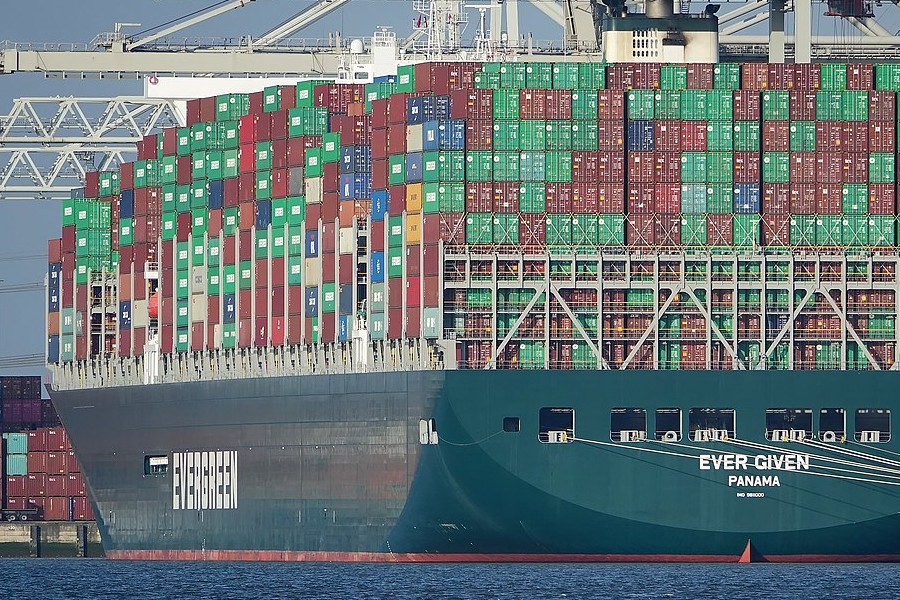The EVER GIVEN grounding
By: Mauricio RIVERA — Posted 2021 Mar 30 under NEWS
The EVER GIVEN ran aground in the SUEZ CANAL on March 23 2021, blocking sea traffic both ways for six days.
Assigned Tags: Headline /

Photo credit: kees torn — EVER GIVEN ( CC BY-SA 2.0 via Wikimedia Commons )
The EVER GIVEN — one of the largest container ships in the world (with a carrying capacity of more than 20,000 twenty foot containers) — ran aground last March 23 2021, supposedly due to high crosswinds, while it was traversing the SUEZ CANAL on its way to the Port of Rotterdam in the Netherlands. This incident resulted in it blocking of one of the world's busiest shipping routes for a total of six days.
Other Interesting Online Posts on the Incident
According to the CNN Article above, 12% of global trade traverses through the SUEZ CANAL — while the RUETERS Article states that 30% of containerized global traffic annually passes through the SUEZ CANAL. Thus, any disruption in the flow of ships and goods through the canal will have repercussions both upstream (on the supplier side) and downstream (on the consumer side).
This incident just highlights the increasing reliance of organizations on externally sourced (i.e. non-local) goods — either due to cost constraints, product / material availability and other considerations. But from a Supply Chain point of view, is this reliance on goods sourced from suppliers located halfway around the world sustainable?
The impact of this incident (or any other disruptive incident) would really depend on where you are in the Supply Chain.
If you are the ultimate consumer — you may not even personally notice the impact of the six day disruption. Or if you do notice it, it may end up being a minor inconvenience.
Unless the goods you are purchasing are out of stock and you have an immediate need for them, the fact that the goods you are purchasing happen to be produced in a far away (or nearby) country just forms one part of your decision making cycle. If the goods you want are not available, then you either shop around some more or wait for the stocks to arrive.
However, if you happen to be a producer of goods — and the goods you have purchased from another country (or state / province) are needed as inputs for the production process — then the EVER GIVEN incident (or again, any other disruptive incident) may have a huge impact on your operations, possibly resulting from late deliveries to line stoppages or lost customers.
Isolated incidents like these (as well as more widespread disruptions, like those brought about by the COVID-19 pandemic) — although infrequent — just emphasize the fragility of Supply Chains that span the globe. Although most purchase and sourcing decisions are based on pricing and availability, these are not the only key considerations when deciding on raw material and goods sources.
Stock and raw material availability is always a concern for producers of goods (as well as traders of goods) — and although buffer stocks can mitigate some stocking and sourcing issues, money used on buffer stocks will ultimately be better used elsewhere.
Analysis
Does the EVER GIVEN incident (and the COVID-19 pandemic) give us enough reasons to do a total review of our Supply Chain? Is the continued reliance on non-local goods sustainable both on the short and long term?
A total review of your Supply Chain, including possible risks and impact due to supply disruptions are good to do on an annual basis. In fact, a regular review of your Supply Chain should cover incidents over the past period(s) and your organizations effectiveness in addressing the incidents.
This annual review should cover the sustainability and viability of all Supply Chain inputs, processes and outputs, especially those that have a significant time component (such as lead time) — either due to preparation, production time or transit time.
In many ways, the EVER GIVEN incident was a wake up call. Most organizations will find it difficult to handle a six day disruption in raw material or goods supply. The COVID-19 pandemic was an even bigger wake up call, as many supply chains were (and are still being) disrupted by localized lockdowns and employee / material supply issues over several months.
Contingency and Reaction Plans will help you prepare for these inevitable disruptions — well thought out plans that include discussions with stakeholders (like suppliers) with tested, validated and rehearsed step-by-step actions will greatly minimize disruptions and the overall negative impact of these incidents on your organization.
